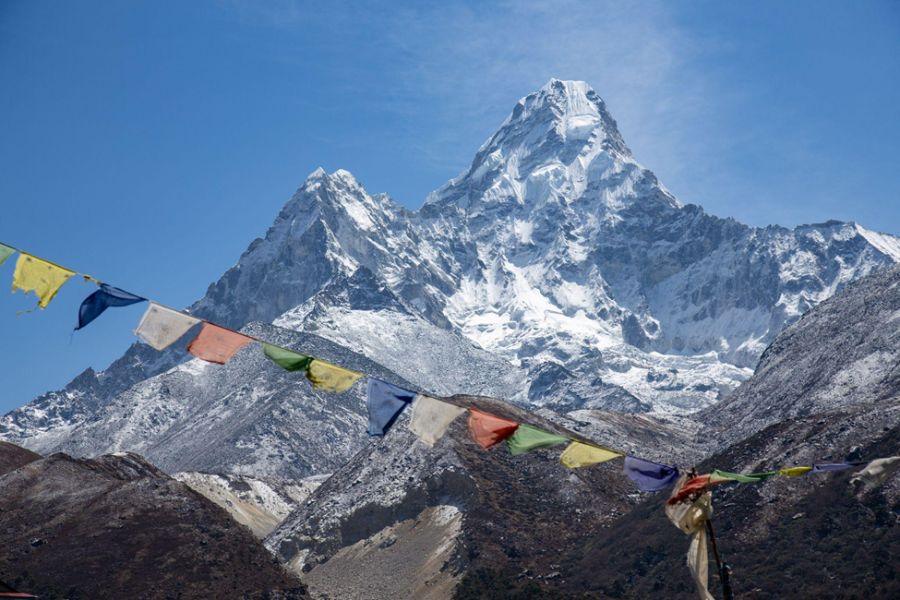Joining on the Everest Base Camp trek and making it all the way from Lukal to EBC is a journey of a lifetime, offering a remarkable blend of adventure, breathtaking landscapes, and ultimately getting a view of the world's highest peaks including tallest Mount Everest.
Located in the heart of the legendary Himalayan Mountain, the Everest Base Camp trek attracts thousands of adventurers every year. This article serves as your comprehensive guide, providing insights into the best season to trek, weather conditions, recommended 12-day itinerary, difficulty level and essential preparation tips.
Best Season and Weather Conditions:
Best season to do Everest Base Camp trek is during the pre-monsoon (spring) and post-monsoon (autumn) seasons. Spring months from March to May and November months from September to November offer stable weather conditions, clearer skies and good visibility. During these seasons, temperatures are moderate, ranging from 10°C (50°F) to 20°C (68°F) during the day. Nights can be colder, with temperatures dropping to around -10°C (14°F). It is important to pack accordingly with warm layers and appropriate gear.
12-Day Itinerary – recommended option:
Day 1: Fly to Lukla, trek to Phakding (2,652m/8,700ft) - 3-4 hours, 8km
Day 2: Trek to Namche Bazaar (3,440m/11,286ft) - 6-7 hours, 10km
Day 3: Acclimatization day in Namche Bazaar
Day 4: Trek to Tengboche (3,860m/12,664ft) - 5-6 hours, 10km
Day 5: Trek to Dingboche (4,410m/14,470ft) - 5-6 hours, 9km
Day 6: Acclimatization day in Dingboche
Day 7: Trek to Lobuche (4,910m/16,104ft) - 5-6 hours, 7km
Day 8: Trek to Gorak Shep (5,170m/16,961ft), visit Everest Base Camp (5,364m/17,598ft) - 6-7 hours, 15km
Day 9: Hike to Kala Patthar (5,545m/18,192ft), trek to Pheriche (4,240m/13,910ft) - 7-8 hours, 15km
Day 10: Trek to Namche Bazaar - 6-7 hours, 14km
Day 11: Trek to Lukla - 6-7 hours, 18km
Day 12: Fly back and transfer to hotel in Kathmandu.
Choosing Everest Base Camp Best Company
When selecting a company for your Everest Base Camp trek, it is essential to consider reputable options with a long-standing history of organizing such expeditions, like Mosaic Adventure. In addition to their experience, it is advisable to review the company's ratings and feedback from previous clients. Furthermore, it would be beneficial to confirm the company's membership in industry associations such as TAAN (Trekking Agencies' Association of Nepal) and NMA (Nepal Mountaineering Association), as this demonstrates their commitment to adhering to professional standards and regulations. By thoroughly examining these factors, you can make an informed decision and choose the best company for your Everest Base Camp adventure.
Difficulty and Experience Required:
Everest Base Camp trek is classified as a moderately challenging trek. While no technical climbing skills are necessary, it does require a good level of fitness and stamina. The trail involves a slow climb with some steep uphill sections and rocky terrain. Previous hiking experience and cardiovascular fitness are not mandatory but really beneficial to enjoy the overall experience.
Regular physical exercise and training are recommended in preparation for the trek. Acclimatization days are safely included in the itinerary to allow your body to slowly adjust to the increasing high altitude.
How to Prepare:
Physical Fitness: Engage in regular aerobic exercises like hiking, cycling, jogging or swimming to improve overall physical endurance. Incorporate strength training exercises to build lower body strength.
Altitude Training: Consider training at high altitudes or using altitude simulation systems to acclimate your body to higher elevations.
Gear and Equipment: Invest in high-quality trekking gear, including sturdy hiking boots, layered clothing for varying temperatures, a reliable backpack, a comfortable sleeping bag and make sure you wisely pack for your Everest Base Camp Trek.
Mental Preparation: Develop a positive mindset, as the trek may present challenges. Stay focused, motivated and prepared for the adventure ahead.
Obtain Necessary Permits: Secure the required permits, including the Sagarmatha National Park Entry Permit, TIMS Card and Khumbu Pasang Lhamu Rural Municipality Permit. You have to obtain TIMS through registered agency in Kathmandu where as other two can be obtained in Kathmandu or upon arrival in Lukla.
Frequently Asked Questions:
Is altitude sickness a concern on the Everest Base Camp trek?
Altitude sickness can affect trekkers at high elevations. Adequate acclimatization, proper hydration, slow and gradual ascent, and awareness of symptoms can help minimize the risk. It is important to consult with a healthcare professional before coming to Nepal to do this trek.
Are there tea houses and food available along the trekking route?
Yes, there are numerous tea houses and lodges along the route that offer basic accommodations and meals. The most popular stops, such as Namche Bazaar and Dingboche, have a variety of food options.
Do I need a guide or porter for the trek?
It is not possible to trek independently, hiring a guide is must. A guide provides valuable insights, ensures your safety and assists with navigating the trail. You can also hire a porter who can help lighten your load, allowing you to focus on enjoying your trip to EBC and back.
Is it necessary to carry cash during the trek?
Yes, you must carry Nepalese currency (Nepali Rupees) for small expenses and emergencies. Credit cards are not accepted along the trekking route.
Conclusion:
Everest Base Camp trek is a thrilling adventure that takes you to the heart of the highest peaks in the world. With proper preparation, choosing right season, and a well planned itinerary, you can go for this ultimate adventure with confidence. Immerse yourself in the beautiful landscapes, rich Sherpa culture and the indomitable spirit of the Everest region. Book your flight to Nepal and discover the wonders of the Everest Base Camp trek and create memories that will last a lifetime.
This is a sponsored article.










